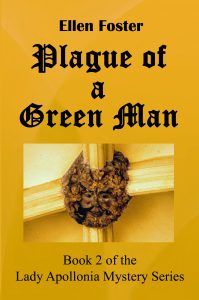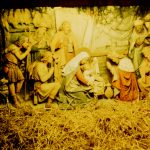 While I am speaking of topics in my second book, Plague of a Green Man, shown on the left, I also seek to describe a medieval Christmas and how differently it would have been celebrated in the 14th century. The Lady Apollonia’s household, Christmas is celebrated near the end of my story. Much of this posti ng is repeated from my posting of December 23, 2016.
While I am speaking of topics in my second book, Plague of a Green Man, shown on the left, I also seek to describe a medieval Christmas and how differently it would have been celebrated in the 14th century. The Lady Apollonia’s household, Christmas is celebrated near the end of my story. Much of this posti ng is repeated from my posting of December 23, 2016.
Some aspects of the celebration of Christmas when Plague of a Green Man was set in 1380, have come down to us today but much has been added to the celebration that was not part of Christmas in Lady Apollonia’s day. The name of the holiday “Christmas” comes from the Middle English usage “Christ’s Mass” when on the 24th and 25th of December, there were three masses celebrated: the Angel’s Mass at midnight, the Shepherd’s Mass at dawn, and the Mass of the Divine Word during the day. In my story, Plague of a Green Man, Lady Apollonia and her husband are able, with her chaplain and household, to observe each of the masses in their family chapel newly built in Exeter House.
A holiday banquet was an important part of the celebration of Christmas in medieval times. We often have turkey for our Christmas dinner, but turkeys came from the New World long after the time of my story. Any medieval family that could afford it in 14th century England would prepare a yule boar for the feast. More humble tables might substitute a meat pie shaped like a boar. Churches, chapels, and homes were colorfully decorated for the holiday with ivy, mistletoe, holly, and anything green in the midst of winter.
In my story, the Lady Apollonia’s Exeter House also included a life-sized crèche, created outdoors in the back garden by Friar Francis, the Lady’s chaplain. The first Christmas crèche was a Franciscan holiday tradition begun in the early 13th century by Saint Francis of Assisi that became popular throughout Europe. The image to the right shows a modern Christmas crèche that my husband and I found in Lichfield Cathedral in England. The medieval version put the emphasis on the Christ child and the animals while the more contemporary crèche has added Mary and Joseph, the shepherds, and wise men.
Medieval Christmas in England was not a single day in the year. All of Advent was a part of its celebration and involved fasting before the major feast on Christmas day. It continued until Epiphany, 12 days later. Some folk even prolonged their festivities for forty days after Christmas until February 2. That part of the holiday had begun as an ancient pagan festival but became Candlemas in the Christian calendar or alternatively celebrated the Presentation of the infant Jesus in the Temple.
 There were special religious days immediately after Christmas Day as well. The first was an important saint’s day honoring Saint Stephen, the first Christian martyr, rather than the Boxing Day holiday on modern English calendars for December 26. The day after that was dedicated to Saint John the Apostle and Evangelist, while December 28 was Holy Innocents’ Day commemorating the male children killed by King Herod. We should also be aware that gifts were not exchanged on a medieval Christmas Day but on New Year’s Day.
There were special religious days immediately after Christmas Day as well. The first was an important saint’s day honoring Saint Stephen, the first Christian martyr, rather than the Boxing Day holiday on modern English calendars for December 26. The day after that was dedicated to Saint John the Apostle and Evangelist, while December 28 was Holy Innocents’ Day commemorating the male children killed by King Herod. We should also be aware that gifts were not exchanged on a medieval Christmas Day but on New Year’s Day.
Please join us next month, to discuss topics from my third Lady Apollonia West Country Mystery, Memento Mori, set in Gloucester in 1392.